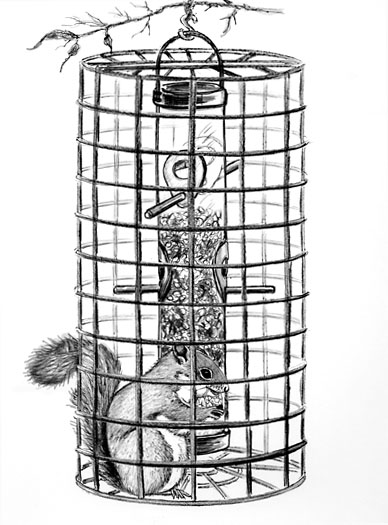
Dear Bird Folks,
A few years ago I bought a squirrel-proof birdfeeder from you and much to my surprise it actually does the job. Try as they might, the gray squirrels have not been able to eat from it. Success! However, that all changed last week when a red squirrel arrived in my yard. Now it sits in the feeder, eats away and screams at anything that tries to interrupt him. Where did this creature come from and how can I keep it out of my feeder?
– Scott, Mystic, CT
Don’t be so surprised, Scott,
Some of the stuff we sell actually does what it’s supposed to do. Not everything we offer is a scam. But you are wise to be skeptical. Last week I saw a notice in the paper from a guy advertising “invisible fences.” What? Is he really trying to sell something that’s “invisible”? Now that sounds like a scam. How would anyone know if it was actually installed? Maybe I should start selling invisible stuff. Just think of the storage room I’d save. Invisible birdseed would certainly help my tired back. And anytime a bird landed in a tree, I could tell people that it’s eating from one of my invisible birdfeeders. I’d sell millions. I have to get working on this one.
The American Red Squirrel is one lucky creature. While the entire human race is cursing its larger cousin, the gray squirrel, old red is getting away with murder, sometimes literally. (More on that later.) The bird feeding industry has spent millions designing feeders that keep out gray squirrels (with moderate success), but they haven’t spent a nickel on the red issue. It’s a clear case of discrimination. Just like kitchen gadgets that are only designed for right-handed people or TV reality shows that are produced for dumb people. Smart lefties have been totally ignored. Fortunately, there aren’t that many of them.
For anyone who hasn’t had the pleasure of dealing with a red squirrel let me fill you in. Red squirrels are small tree squirrels. They are fluffy and red, looking like a cross between a chipmunk and that thing that lives on Donald Trump’s head; only they aren’t as cute as the former and not as creepy as the latter. They are highly energetic and feisty, although both descriptions are an understatement. Red squirrels have the energy of a yapping dog, combined with the patience of a Tasmanian devil. (It has been estimated that the energy produced by a single red squirrel could power a small town for a year, but the crooks at the big oil companies have been fighting to keep us from knowing it.)
Red Squirrels are often referred to as “pine squirrels” because their life revolves around pine trees and pinecones. They harvest green pinecones by chewing them right off the branch. The cones are then stashed in a hidden location for later use. It’s easy to tell if red squirrels are in your area because you’ll find large piles of shredded pinecones on the ground. These piles are called “middens.” I really don’t have anything else to say about middens. I just felt like tossing in a random fact. Do with it what you may.
In addition to pine seeds, they eat nuts and may occasionally eat bird eggs, young birds and even baby rabbits. (Here’s the, “getting away with murder” thin I mentioned earlier. I know eating rabbits doesn’t constitute murder, but try telling that to the rabbits.) Before we start thinking of these squirrels as barbarians, you should know they also have a sophisticated side. It seems red squirrels have an appetite for mushrooms. However, they don’t just chow down the mushrooms where they find them. They first carry them up in a tree, place them on a branch and allow them to dry in the sun to become more flavorful before they eat them…or before sautéing them with baby rabbits.
So far, we’ve learned what a midden is and that red squirrels are gourmet cooks, but how do we keep them off our birdfeeders? The answer to this isn’t easy. That’s why it has taken me so long to get to it. Most squirrel-proof feeders operate on either one or two principles, both of which are designed with the gray squirrel in mind. A feeder either closes when a heavy squirrel sits on it, or it has some kind of wire cage around it, which allows the small birds inside to eat, but keeps the fat squirrels out. Like chipmunks, red squirrels are often too light to close a feeder when they sit on it. They are also small enough to fit through most wire cages. This fact is not only annoying to anyone who feeds birds, but it’s equally annoying to me because I have to listen to folks complain about it.
The best way to keep either a gray or red squirrel off of a feeder is to get a good old squirrel baffle. Red squirrels can’t get around them. (And I’m talking about a real baffle, not a used salad bowl or a trashcan cover.) A squirrel baffle designed either for a pole or to be hung off a tree branch will do the trick for you, Scott. Just remember, squirrels are great jumpers. Neither baffle will work unless they it is placed at least five feet above the ground and ten feet away from the nearest tree, bush, fence or midden. If you can’t find a baffle in your area, give me a call. I have a batch of invisible squirrel baffles coming in next week. I’ll give you a good deal on one. Honest.